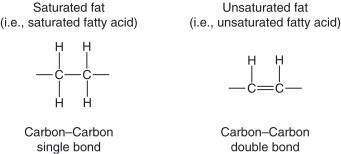Lipids are oils and fats, with oils being the liquid form while fats being the solid form of the substance. The types of oils consist of monounsaturated and polyunsaturated fats, generally known as unsaturated fats. Unsaturated fats are considered beneficial in appropriate amounts and are associated with improved cholesterol, decreased inflammation, and other health benefits. Monounsaturated fats focus on cholesterol maintenance and include products like olive and canola oil, avocados, and many nuts. Polyunsaturated fats provide essential fatty acids and include corn oil, sesame oil, soya oil, omega-3, and other associated products.
Meanwhile, fats can be saturated and trans fats. Saturated fats are a less healthy mix of fats in a food product. Most foods have some level of saturated fats, but levels differ and can be damaging to health in high amounts, with guidelines recommending less than 10% of calories stem from this category. Saturated fats include coconut oil, palm oil, and palm kernel oil. Finally, trans fats are created when liquid vegetable oils are heated in combination with hydrogen gas, which uses a process known as hydrogenation, sometimes industrially converted into solids. Trans fats are extremely unhealthy for the cardiovascular system and cholesterol levels. These are present in fried foods and include hydrogenated vegetable oil or in high-fat products such as margarine.
Fats and oils are essential micronutrients of the body. Both fats and oils are long-chain fatty acids composed of carbon (C), hydrogen (H), and oxygen (O) which combine to form fatty acids. Oils in the form of monounsaturated and polyunsaturated fats have a single carbon double bond. As can be seen in the diagram below, fatty acids are missing a pair of hydrogen atoms at the end of the chain, leaving the carbon atoms to be then connected by a double bond rather than a single one known as unsaturated fats. One double bond is known as monounsaturated, while more than one gap is known as polyunsaturated. Oils are known to be composed of unsaturated fatty acids with low oxidative rancidity (Pietrangelo 2022).
Meanwhile, saturated fat has the hydrocarbon chain that is ‘saturated’ with hydrogen atoms, based on the lack of a double bond, with the general formula being CnH2nO2, having twice as many hydrogen atoms as carbon. Since saturated fats are solid at room temperature and have no double bonds, there are gaps that are filled with hydrogen molecules. As discussed earlier, trans fats are created by adding hydrogen to the liquid vegetable oil, making it into solid fat. Oxidative rancidity is high in fats (Pietrangelo 2022). Therefore, the chemical difference between unsaturated and saturated fats lies in the inherent number of double bonds in the fatty acid chain or a lack thereof as in saturated fats. There are no other physical differences other than those unsaturated fats are liquid from plant sources, while saturated fats are solid and stem from animal sources.

Lipids, including both unsaturated and saturated fats, have an important place in the diet of humans, contributing to a range of bodily functions. Fats provide body energy, allow for cell growth, protect organs, help with nutrient absorption, and influence body pressure and cholesterol levels. Lipids are a source of essential fatty acids that the body cannot produce on its own. Fats also help the body absorb a range of vitamins, including vitamins A, D, and E, which are fat-soluble, meaning that they can only be absorbed with the help of fats. Fat is high in energy, whether saturated or unsaturated, producing 9kcal per gram in comparison to just 4kcal from carbohydrates and protein (NHS 2020). A limited amount of fat is critical for a healthy and balanced diet. It is preferred that the majority of those fats be unsaturated due to the unhealthy impact on cholesterol and the heart from the high prevalence of saturated fats. However, most fats and oils contain both saturated and unsaturated fats in various proportions.
Recent advancement in food processing has been to develop non-thermal technologies in food processing where it is treated at near-room temperature without damaging the food. Food undergoes multiple thermal treatments during various processes to enhance shelf life and then during its preparation and final heating for consumption. The thermal treatments cause the nutritional quality of the food to deteriorate along with some impacts on the structure, texture, and even chemical composition (Jadhav, Annapure, and Deshmukh 2021). The new technology allows for providing clean and safe food without compromising nutritional components. Non-thermal technologies can be used on everything from vegetables to meat.
For lipids, such technology is vital since thermal treatment causes lipid oxidation that dramatically changes the composition of fatty acids. It makes the final product susceptible to oxidation, which decreases quality and taste. In non-thermal processing, food is exposed to ambient temperatures for time periods that do not impact nutritional composition in the long term. Furthermore, it is more sustainable since thermal technologies require tremendous energy to produce low-quality food, while this innovative approach is environmentally friendly by using elements such as cold plasma, ultrasonication, and pulsed electric field (Jadhav et al. 2021
Reference List
Jadhav, Harsh Bhaskar, Uday S. Annapure, and Rajendra R. Deshmukh. 2021. “Non-Thermal Technologies for Food Processing.” Frontiers in Nutrition 8. Web.
NHS. 2020. “Fat: The Facts.” NHS UK. Web.
Pietrangelo, Ann. 2022. “What’s the Difference Between Saturated and Unsaturated Fat?” Healthline. Web.
